The Turk Chess Automaton, often simply called “The Turk,” was an 18th-century mechanical marvel that fascinated and mystified audiences worldwide. Created by Wolfgang von Kempelen in 1770, it was presented as an automated chess player capable of defeating human opponents. Despite its mechanical appearance, the true secret behind The Turk lay in its clever design and the skilled human operators hidden within.
The Creation of The Turk
Wolfgang von Kempelen
Wolfgang von Kempelen, a Hungarian engineer and inventor, built The Turk to impress Empress Maria Theresa of Austria. The machine was designed to appear as an automaton capable of playing chess autonomously, complete with a life-sized model of a human figure dressed in Turkish attire. Kempelen’s primary goal was to create a spectacle that would intrigue and entertain the court.
Design and Construction
The Turk consisted of a large wooden cabinet with a chessboard on top and a life-sized figure dressed in traditional Turkish clothing. The cabinet was cleverly designed with compartments and sliding panels, allowing a human chess player to hide inside and manipulate the automaton’s arm to move the chess pieces. The intricate design included gears, levers, and magnets to create the illusion of autonomous operation.
The Performances and Tours
Initial Success
Kempelen first showcased The Turk in 1770, and it quickly became a sensation. The automaton played against various opponents, including nobility and chess masters, often emerging victorious. Its success led Kempelen to tour Europe, demonstrating the marvel in cities such as Paris, London, and Vienna.
Legendary Opponents
The Turk played against numerous notable figures, including Benjamin Franklin and Napoleon Bonaparte. These encounters only heightened the mystique and reputation of The Turk as an unbeatable mechanical genius. Each performance captivated audiences, who were eager to witness the marvel in action.
The Secret Behind The Turk
Hidden Human Operators
The true secret of The Turk’s success was the presence of a skilled human chess player hidden inside the cabinet. This operator controlled the movements of the automaton, ensuring that it played competently and often brilliantly. The design allowed the hidden player to see the chessboard and manipulate the mechanical arm without detection.
Deception Techniques
Kempelen employed various techniques to maintain the illusion. Before each performance, he would open the cabinet doors to show the intricate machinery, giving the impression that the automaton was purely mechanical. This clever misdirection, combined with the complexity of the design, kept the secret safe for many years.
The Legacy of The Turk
Influence on Automata and AI
The Turk had a lasting impact on the world of automata and early artificial intelligence. It inspired future inventors and engineers to explore the possibilities of mechanical and computational devices. The mystery and allure of The Turk continued to capture the imagination long after its performances ended.
Modern Interpretations
Today, The Turk is remembered as a fascinating example of early engineering and showmanship. It serves as a reminder of the lengths to which inventors have gone to create illusions and entertain audiences. The story of The Turk continues to be a topic of interest for historians, chess enthusiasts, and those intrigued by the history of technology.
Conclusion
The Turk Chess Automaton remains one of the most intriguing and mysterious creations in the history of chess and mechanical engineering. Its ability to captivate audiences and outwit human opponents, all while concealing a human operator, speaks to the ingenuity and creativity of its creator, Wolfgang von Kempelen. The legacy of The Turk endures, symbolizing the endless pursuit of innovation and the timeless allure of mystery and deception.






